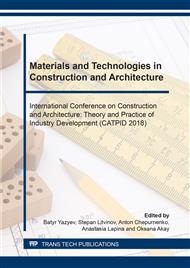[1]
V. A. Il'ichev, Biosphere compatibility of nature and man is the way to a systemic solution of global problems, Strategic Priorities. 1 (2014) 42–58. (In Russian).
Google Scholar
[2]
V.A. Il'ichev, S.G. Emel'janov, V.I. Kolchunov, N.V. Bakaeva, S.A. Kobeleva, Modeling and analysis of the laws of dynamics of the biosphere-compatible urban areas, Housing Construction. 3 (2015) 3–9. (In Russian).
Google Scholar
[3]
V. Ja. Ljubovnyj, Regulation of urban planning in the changing conditions of Russia's development, Academia. Architecture and Construction. 1 (2016) 57–63. (In Russian).
Google Scholar
[4]
E. V. Sherbina, N. V. Danilina and D. N. Vlasov, City planning issues for sustainable development, International Journal of Applied Engineering Research. 10 (22) (2015) 43131–43138.
Google Scholar
[5]
G. M. Lappo and V. Ya. Lyubovnyi, Largest Urban Agglomerations in Russia at the Beginning of the 21st Century: Status, Problems, and Approaches to Their Solution. Regional Research of Russia. 1 (2) (2011) 133–140.
DOI: 10.1134/s2079970511020109
Google Scholar
[6]
Elena Shcherbina and Elena Gorbenkova Transformation of Belarus and Russian agricultural settlement system in the new economic conditions (post-Soviet period), MATEC Web of Conf. 86 (2016).
DOI: 10.1051/matecconf/20168607002
Google Scholar
[7]
V. S. Vagin, S. G. Sheina, K. V. Chubarova, Principles and factors of sustainable development of urban areas, Scientific open access journal «Naukovedenie». 7 (3) (2015) (In Russian).
Google Scholar
[8]
S. G. Sheina, A. A. Hamavova, N.A. Ismatulaeva, The comfortable conditions for living: the new standards of the territories stable development, The Don Engineering Herald. 3 (2015) (In Russian).
Google Scholar
[9]
S. G. Sheina and A. A. Khamavova, Technique for the Russian Federation Regional Territories Assessment Used to Create Industrial Parks Network, Proceedia Engineering. 150 (2016) 1960–1965.
DOI: 10.1016/j.proeng.2016.07.198
Google Scholar
[10]
E.V. Gorbenkova, The method for estimating the level of rural settlements development, Science Review. 12 (1) (2014) 210–218. (In Russian).
Google Scholar
[11]
E. V. Shcherbina and E. V. Gorbenkova, The importance of socio-demographic factors for a sustainable development of agro-towns, Science Review. 9 (2013) 128–131. (In Russian).
Google Scholar
[12]
E. V. Shcherbina and E. V. Gorbenkova, Evaluation the factors for the sustainable development of rural settlements, Biospheric compatibility: human, region, technologies. 4 (16) (2016) 97–105. (In Russian).
Google Scholar
[13]
Elena Shcherbina, Elena Gorbenkova and Mikhail Slepnev, Urban-planning sustainability problems in a city natural framework, MATEC Web Conf. 106 (2017) 01032.
DOI: 10.1051/matecconf/201710601032
Google Scholar
[14]
E.V. Gorbenkova and E.V. Shcherbina, Methodological Approaches for Modeling the Rural Settlement Development, Vestnik MGSU. 12 (10) (2017) 1107–1114.
DOI: 10.22227/1997-0935.2017.10.1107-1114
Google Scholar
[15]
A.A. Akgun, E.S. Leeuwen, P. van Nijkamp, A systemic perspective on multi-stakeholder sustainable development strategies, in: Serie Research Memoranda 0009, VU University Amsterdam, Faculty of Economics, Business Administration and Econometrics, (2011).
Google Scholar
[16]
A.A. Akgun, T. Baycan, P. Nijkamp, Repositioning rural areas as promising future hot spots, in: Serie Research Memoranda 0013, VU University Amsterdam, Faculty of Economics, Business Administration and Econometrics, (2011).
Google Scholar
[17]
Aliye Ahu Gulumser, Tuzin Baycan-Levent, Peter Nijkamp, Creative capacity for sustainable development: A comparative analysis of European and Turkish rural regions, in: ERSA conference papers 10 p.451, European Regional Science Association, (2011).
DOI: 10.1504/ijfip.2011.040073
Google Scholar
[18]
M. Forleo, V. Giaccio, A. Giannelli, L. Mastronardi and N. Palmieri, Socio-Economic Drivers, Land Cover Changes and the Dynamics of Rural Settlements: Mt. Matese Area (Italy), European Countryside. 9 (3) (2017).
DOI: 10.1515/euco-2017-0026
Google Scholar
[19]
J. Van Vliet, H. L.de Groot, P. Rietveld, P. H.Verburg, Manifestations and underlying drivers of agricultural land use change in Europe. Landscape and Urban Planning. 133 (2014) 24–36.
DOI: 10.1016/j.landurbplan.2014.09.001
Google Scholar


